#fiat 750 spider
Text


1963 Moretti Fiat 750 Spider
My tumblr-blogs: https://www.tumblr.com/blog/germancarssince1946 & https://www.tumblr.com/blog/frenchcarssince1946 & https://www.tumblr.com/blog/englishcarssince1946 & https://www.tumblr.com/blog/italiancarssince1946 & https://www.tumblr.com/blog/japanesecarssince1947
2 notes
·
View notes
Photo


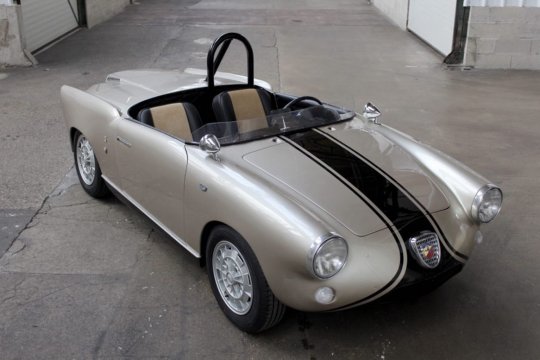


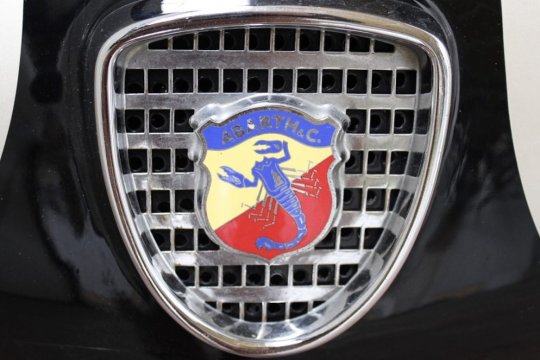



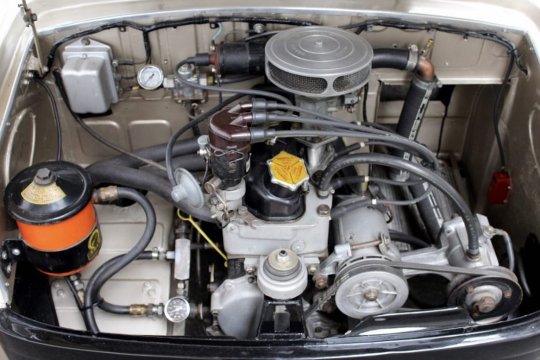
Abarth 750 Allemano Aluminum Spider
Serafino Allemano founded his Carrozzeria in 1928, starting as a repairer for other brands, especially Italian ones. A few years later he decided to create his own designs, he designed and manufactured some exclusive series for Maserati, Alfa Romeo, Lancia until 1965. The 750 Allemano Spider was commissioned by Abarth because some racing drivers preferred open cars, in addition to the fact that the American market was crazy about roadsters. It is based on the Fiat 600 structure with an aluminum spider body and Plexiglass windscreen, equipped with Campagnolo alloy wheels. The Abarth four-cylinder engine of 747 cc increased to 44 horsepower at 5800 rpm allows to exceed 150 km/h coupled with a 4-speed synchronized gearbox. The Spider Allemano was very popular in competition around the world for its light weight of 550kg.
This Fiat Abarth 750 Allemano Spider, chassis number 476565 and engine number 667974 had been prepared for American races in the 60's.
165 notes
·
View notes
Photo

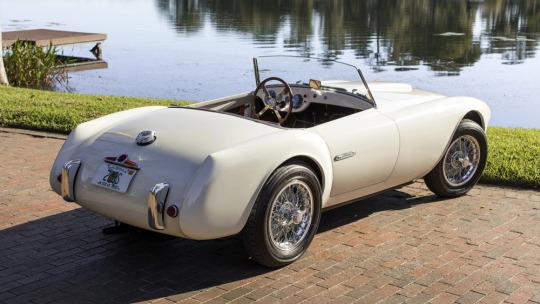


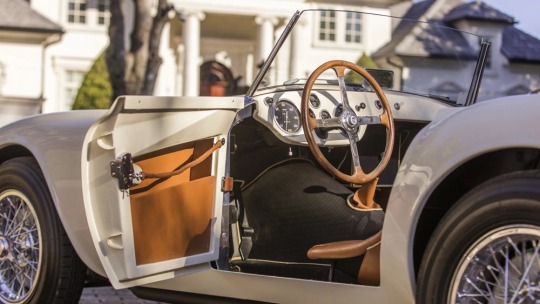
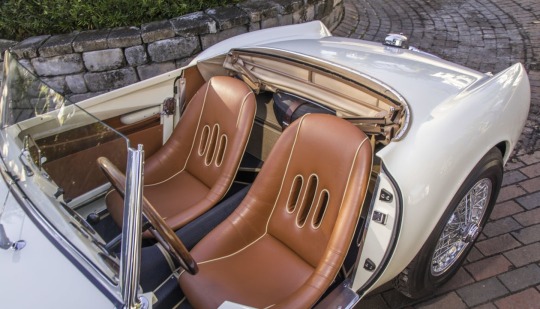
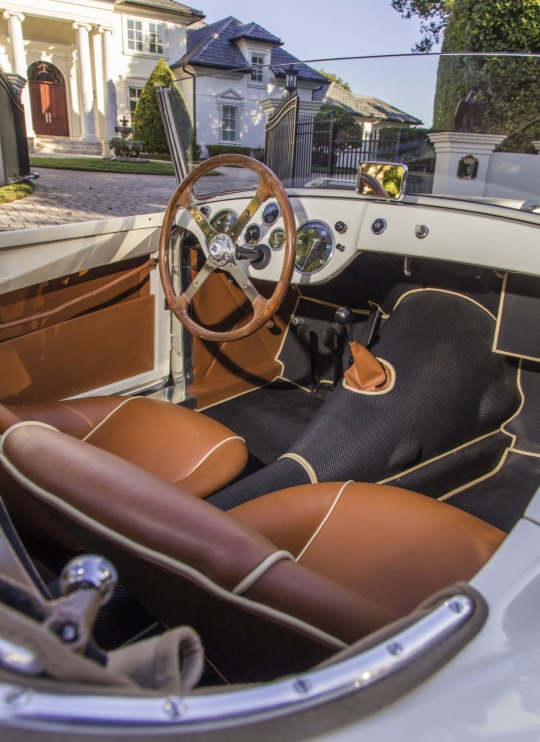
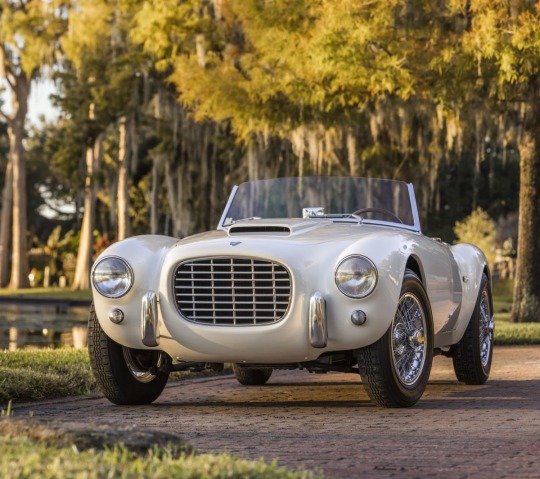


1953 Siata 208S Spider
Siata is an acronym for Società Italiana Auto Trasformazione Accessori, the Turin-based firm founded in 1926 by Giorgio Ambrosini, and which ceased production in 1970.
Much like Abarth, Siata developed its business by manufacturing performance parts for Fiat, gaining greater exposure after World War II as motorsport came back to the fore in Europe and the Americas. As 750 cc-powered race cars grew in displacement, Siata-modified vehicles gained prominence and the attention of stateside racers like Briggs Cunningham and Ernie McAfee. The latter was a Los Angeles–based importer who drove one of the first Siata-enhanced examples in the 1953 Carrera Panamericana race.
Fiat, meanwhile, had developed a 2.0-liter V-8 engine for its luxury sports car, the Otto Vu. While only 49 examples of that model were constructed, there remained additional Fiat V-8 engines that were acquired by Siata to power its new 208S Spider, unveiled in 1952. Only 33 examples were bodied by Carrozzeria Rocca Motta, of Turin, from 1953 to 1955. The car was not only powerful for its day, but supremely beautiful.
Designed by Giovanni Michelotti, these perfectly proportioned roadsters defined the iconic look of the era’s rugged sports cars. Equally stunning was the 208 CS, a coupe version of which only 18 were made, 11 bodied by Balbo and seven by Stabilimenti Farina. Topped with twin Weber carburetors and tuned by Siata, Fiat’s 2.0-liter OHV alloy V-8 engine develops more than 125 hp at 6,000 rpm, which is good enough to give the car a top speed of nearly 125 mph.
#art#design#sportcars#sportcar#luxurycars#luxurycar#vintagecars#vintagecar#siata#fiat#italy#giorgio ambrosini#spider#1953#giovanni michelotti#roadster#208 CS#siata 208 CS
1K notes
·
View notes
Text
Went to get my papillomavirus shot and what did the decrepit old mall have in store for me but a Ferrari 360 Modena, called as much in honor of the famous Modena circuits, a lovely Alfa Romeo GT "Scalino", called as much because it was a Grand Tourer (man, I need to finish the body styles masterpost) with a 1300cc (cubic centimeters, you filthy yanks) engine and nicknamed as much because this specific version had a front end that left a small step-like gap between front bumper and hood...

...a Lamborghini Gallardo Spyder, called as much because the roof folds down...

...a lovely Alfa Romeo Giulietta Spider, called as much because "real Italians spell it with an i" or something...

...and finally, probably the most valuable of all of these, a fantastic Fiat-Abarth 750 Zagato, called as much because the 600 it was based on was the work of Fiat, its 750cc engine the work of Abarth, which back then flanked the name of the brand whose car they were tuning rather than outright taking their spot as it does now, and the spectacular bodywork of coachbuilder Zagato.

I mean, just look at the non-Zagato version.
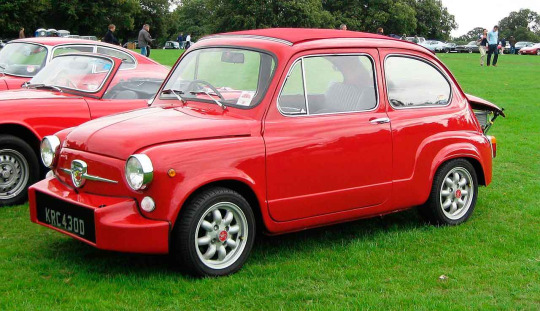
Talk about a glowup.
S'yah. Get your shots, folx, the world may just smile your way! :)
#ferrari 360 modena#alfa romeo gt#lamborghini gallardo#alfa romeo giulietta#fiat-abarth 750 zagato#fiat 600
18 notes
·
View notes
Text
The Art of the Slowpoke, or How I Stopped Caring About HP

This is the Lamborghini SC20. It's a one off, some 750 HP and uh, well no roof. I don't know the name of this style, but it has been a thing with a lot of one-off, or limited run cars. I don't really get it, but to be frank, I don't really hate it either. I do like this car, it's a nice design, the color scheming is rather different (when was the last time you saw a stock blue & white Lambo?), but to be frank, I would never own it. Yeah, I couldn't afford it ever my life, but even if I could, it wouldn't be my first pick of car. Hell, it wouldn't even be the first Lamborghini I'd go for. That'd be the Diablo. But, well, there's still a dozen dozen cars I'd go for first.

Frankly, it'd be something like this. An AMC Gremlin. A little shitbox American car from the mid-70s with a V8 that barely shits out as much power as a modern Miata. Top speed of 100 when it goes downwind, bodywork with more rust than solid metal, cheap as shit. It's perfect. It's pure, shithole 70's Detroit, when the oil crisis meant "lets make the worst fucking cars imaginable and kill the muscle car."

Meanwhile, only 5-6 years ago, Italy pushed out this absolute centerfold of a car, the Alfa Romeo 33 Stradale, a car with as much horsepower as an RX8 but enough oomph to still hit 200 mph. In 1968. It's one of those multi-million dollar cars nowadays, a holy grail of ownership that half the examples are probably rotting away in some dickhead's collection. And I absolutely adore this car, don't get me wrong. I'd kill to drive this for a day, even. But I'd still buy a Gremlin first.

Cool shitboxes really aren't a thing anymore, frankly. Low horsepower, but high fun factor. Japan puts out a lot of cheap, sporty cars, sure, but a lot pale in comparison to their older generations. Would sooner buy a '93 Civic than a '23. But in a fun, almost poetic twist, you have thisun. The Abarth 124 Spider. Well, it's mostly a Miata, but all the fixin's are done up by Abarth. It's still only 165 HP, less than a fucking Kia Soul Turbo, but come on, would you really buy one of those over this? The Miata might've turned from the hairdresser car to the weird cult icon it's become in recent years, but this one stands out from the rest. The Fiata as they call it, sounding 100 HP more aggressive than it is, only able to hit 140 on a good day. And it goes racing. Brings to mind something else, really...

Yeah, the Ford Escort. A car that started life as a cheap family car, a replacement for the Anglia (The stupid flying car from Harry Potter), turned into a long running icon of Ford's rallying success. It's a tale not unheard of in the sport, the Fiat 131 in the 80's was a similar story, but its an inspiring story. Something so simple, so low-power, under the radar, turning into a motoring icon on the dirt. That is something I just adore. Seeing these cars some would consider lower echelon becoming full-blown powerhouses almost out of nowhere. Something that a lot of cars have kinda lost. Sure, the Focus is a cheap, fun car, but it's been pretty heavily involved with motorsport that it kinda loses its luster.

Cases like this fucking drift Corolla. Who fucking cares about the Toyota Corolla? It's arguably played second fiddle to the Celica for a long time, but here you have this one that's a part of the Formula Drift circuit, sporting over a thousand horsepower, it's barely even close to the original. But god you have to just love this thing. The engineering behind it, the sheer insanity of it. The gall to take something so basic, so common, and make it a contender in the drift scene. That is some real love for the little guy. A love that has really been left wanting in the modern times.
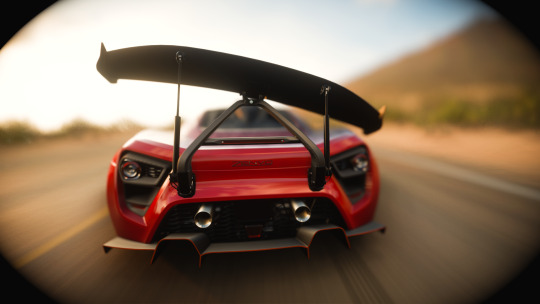
In a world where you have active-aero so ridiculously advanced it tilts in 20 different directions at different speeds on a road car, there's not much fun for the little guy. There's a reason that so many slower, yet interesting cars are all 15+ years old. Automakers, owners, hell, most people don't have cars to care about these days. The age of the SUV is upon us. And yeah, some of those are pretty interesting, fast and powerful. But even the 70's and 80's put out more interesting garbage than most modern stuff. Just look at the new Integra. What about that screams "Integra?"

This was a bunch of rambling that really didn't pay much attention to the topic I wanted to talk about, but maybe the point gets across. Power and luxury don't make a dream car, always. Just spirit, a love for the machine, and maybe just a pinch of personal experience.
6 notes
·
View notes
Photo

1953 Siata 208S Spider Siata is an acronym for Società Italiana Auto Trasformazione Accessori, the Turin-based firm founded in 1926 by Giorgio Ambrosini, and which ceased production in 1970. Much like Abarth, Siata developed its business by manufacturing performance parts for Fiat, gaining greater exposure after World War II as motorsport came back to the fore in Europe and the Americas. As 750 cc-powered race cars grew in displacement, Siata-modified vehicles gained prominence and the attention of stateside racers like Briggs Cunningham and Ernie McAfee. The latter was a Los Angeles–based importer who drove one of the first Siata-enhanced examples in the 1953 Carrera Panamericana race. Fiat, meanwhile, had developed a 2.0-liter V-8 engine for its luxury sports car, the Otto Vu. While only 49 examples of that model were constructed, there remained additional Fiat V-8 engines that were acquired by Siata to power its new 208S Spider, unveiled in 1952. Only 33 examples were bodied by Carrozzeria Rocca Motta, of Turin, from 1953 to 1955. The car was not only powerful for its day, but supremely beautiful.Designed by Giovanni Michelotti, these perfectly proportioned roadsters defined the iconic look of the era’s rugged sports cars. Equally stunning was the 208 CS, a coupe version of which only 18 were made, 11 bodied by Balbo and seven by Stabilimenti Farina. Topped with twin Weber carburetors and tuned by Siata, Fiat’s 2.0-liter OHV alloy V-8 engine develops more than 125 hp at 6,000 rpm, which is good enough to give the car a top speed of nearly 125 mph.
#art#design#sportcars#sportcar#luxurycars#luxurycar#vintagecars#vintagecar#siata#fiat#italy#giorgio ambrosini#spider#1953#giovanni michelotti#roadster#208 CS#siata 208 CS
5 notes
·
View notes
Link
1958 Fiat 1100-1200 by Moretti Shortly after the release of the 750, in 1954, #Moretti introduced the 1200. Using a 1204cc twin-cam engine with 62bhp, it was built with various coupe bodies. #Fiat #1950s
0 notes
Text
Who's who: 1958 Abarth 750 Spyder by Zagato
Who’s who: 1958 Abarth 750 Spyder by Zagato


And here comes another special car based on the Fiat 600, this time with an open body made by Zagato.

In fact we have seen cars similar to this one, but they had the bodywork built by Allemano and they are quite well known as several dozen have been produced: this car instead seems to be the prototype of a lot of three cars, and it seems that this was exhibited at the Turin Motor Show in 1958.

View On WordPress
18 notes
·
View notes
Photo



Abarth 750 Spyder, 1957, by Zagato. Based on the Fiat 600 with the engine bored and stroked out to 747cc, only 3 or 4 spider versions were made as the design was rejected by Carlo Abarth though Abarth built the hardtop coupé version between 1956 and 1960
136 notes
·
View notes
Photo

Fiat Abarth 750 Spider Allemano 1959. - source Centro Storico Fiat.
31 notes
·
View notes
Photo










Fiat 750 Vignale
Carrozzeria Vignale of Turin was founded in 1948 by Alfredo Vignale, it would become one of the most iconic and respected of the Italian coachbuilders. Vignale designed cars, most often low volume variants of main production cars from manufacturers such as Ferrari, Lancia and Maserati. As well as Vignale-penned designs for the previously mentioned titans of the industry, the Turin-based design house was often enlisted by Fiat for prototypes, motor-show concepts and limited editions, much like the 750 which came in Coupe, Berlinetta and Spider body-styles. In essence a Fiat 600, an icon of the Italian economic boom, with its four-cyclinder engine increased from 600cc to a rather zippy 750cc. The bodywork was completely re-styled by Vignale with sleek 1960’s Italian styling just as well suited to some of Fiat’s Italian contemporaries; the car was bodied at a new factory in Grugliasco, near Mirafiori, whilst the Maserati and Lancia coachwork continued to be done in Turin. The 750 on offer here, finished in a classic colour combination of red with black interior, was produced in 1964.
39 notes
·
View notes
Photo

Moretti as a manufacturer came to an end thirty years ago this month, after 64 years of producing motorcycles, sports cars, and what it was best known for by 1989 - Fiat based specials. The Moretti 850 Sportiva, as you can guess based on the Fiat 850, was one of the coolest. A (very) Miniature Fiat Dino wrapped around the mechanicals of a simpler car and meant as something special for style-conscious Italians wanting to stand out. And they really had to want to - because the style didn’t come cheap. - Founded in 1925 by Giovanni Moretti to make motorcycles, the company went through four distinct phases. The early years were two-wheeled, but the company branched out into proper cars in 1947 with the Cita, a Topolino-sized flat-twin 2-door with an almost Austin A-40 like body. Moretti built its own small sports cars - including the very fast for its size 750 - into the late 1950s before concentrating on rebodied or modified Fiats - phase 3. The golden age of these cars was the 1960s into the early 1980s, but Moretti went into terminal decline. - The genesis of the 850 Sportiva arguably starts when its designer, Swiss-born Dany Brawand, met Giovanni Michelotti as a trainee at Ghia-Aigle in 1952. Brawand followed Michelotti to his own company 1959, where he worked on many designs bound for Moretti. The two had a falling out in 1965, and Brawand moved to Moretti full time, remaining its design director for the next 24 years. Moretti’s own cars, meanwhile, were unsustainable. Economies of scale could only be achieved with off-the-rack parts. Moretti’s personal friendship with Gianni Agnelli led to a deal where Moretti was able to use Fiat pieces, though that made them essentially coachbuilt Fiats from then on. - The Sportiva, with Brawand’s lines and Fiat’s pieces, emerged at the 1965 Turin show, long before the Dino spider, but only went into production some months later. The design was visually deceptive - it looks large but is actually only 41” tall on an 80” wheelbase - tiny. The heavy body made it slower at twice the price than the 850, but undeniably sexy. This particular car is lowered (original ones have big wheel gaps). Sportivas was built into 1971. https://www.instagram.com/p/B6Vz7x6l5_M/?igshid=1mrfqkn56ml17
0 notes
Text
2019 Mazda MX-5 Miata Fuel Economy Revealed
Although Mazda is adding 26 more hp to the Miata, fuel economy will remain similar to last year’s numbers. According to FuelEconomy.gov, the 2019 Mazda MX-5 Miata is estimated to achieve 26/35/30 mpg with the six-speed automatic, compared to 26/35/29 mpg from last year. The six-speed manual nets 26/34/29 mpg, ahead of last year’s 26/33/29 mpg.
If you opt for the automatic-equipped Miata, you’ll pay $750 more in fuel costs over a five-year period compared to the average new vehicle, the website says. With the manual, you’re expected to pay $1,000 more.
As we reported earlier, the Miata now makes 181 hp from its 2.0-liter engine. Torque has increased from 148 lb-ft to 151 lb-ft, and redline has jumped from 6,800 rpm to 7,500 rpm.
For the new model year, Mazda made a number of mechanical changes to improve both performance and efficiency. These updates include lighter pistons and connecting rods, in addition to reconfigured intake ports and higher-pressure fuel injectors. To reduce exhaust loss, Mazda updated the engine with an increased valve opening angle and valve lift height, and it increased the inner diameter of the exhaust manifold. A low-inertia, dual-mass flywheel promises increased responsiveness over the old single-mass flywheel.
The Miata’s fuel economy is competitive with rivals. The 2019 Fiat 124 Spider tops out at 26/35/30 mpg, and the 2018 Subaru BRZ can get up to 24/33/27 mpg.
Source: FuelEconomy.gov
The post 2019 Mazda MX-5 Miata Fuel Economy Revealed appeared first on Motor Trend.
via RSSMix.com Mix ID 8134279 https://ift.tt/2utnC5B
0 notes
Photo

1953 Siata 208S Spider Siata is an acronym for Società Italiana Auto Trasformazione Accessori, the Turin-based firm founded in 1926 by Giorgio Ambrosini, and which ceased production in 1970. Much like Abarth, Siata developed its business by manufacturing performance parts for Fiat, gaining greater exposure after World War II as motorsport came back to the fore in Europe and the Americas. As 750 cc-powered race cars grew in displacement, Siata-modified vehicles gained prominence and the attention of stateside racers like Briggs Cunningham and Ernie McAfee. The latter was a Los Angeles–based importer who drove one of the first Siata-enhanced examples in the 1953 Carrera Panamericana race. Fiat, meanwhile, had developed a 2.0-liter V-8 engine for its luxury sports car, the Otto Vu. While only 49 examples of that model were constructed, there remained additional Fiat V-8 engines that were acquired by Siata to power its new 208S Spider, unveiled in 1952. Only 33 examples were bodied by Carrozzeria Rocca Motta, of Turin, from 1953 to 1955. The car was not only powerful for its day, but supremely beautiful.Designed by Giovanni Michelotti, these perfectly proportioned roadsters defined the iconic look of the era’s rugged sports cars. Equally stunning was the 208 CS, a coupe version of which only 18 were made, 11 bodied by Balbo and seven by Stabilimenti Farina. Topped with twin Weber carburetors and tuned by Siata, Fiat’s 2.0-liter OHV alloy V-8 engine develops more than 125 hp at 6,000 rpm, which is good enough to give the car a top speed of nearly 125 mph.
#art#design#sportcars#sportcar#luxurycars#luxurycar#vintagecars#vintagecar#siata#fiat#italy#giorgio ambrosini#spider#1953#giovanni michelotti#roadster#208 CS#siata 208 CS
0 notes
Link
1958 Fiat 1100-1200 by Moretti Shortly after the release of the 750, in 1954, #Moretti introduced the 1200. Using a 1204cc twin-cam engine with 62bhp, it was built with various coupe bodies. #Fiat #1950s
0 notes
Text
H Class racer: 1959 Abarth 750 Spider by Allemano
H Class racer: 1959 Abarth 750 Spider by Allemano

We wrote several times about these special Abarth built on the Fiat 600 chassis with an aluminium body designed and crafted by Allemano but, as long as we like them, we don’t miss a chance to publish one when we find it for sale.

This car was delivered new in the U.S.A. and soon it was converted in a racer (when new, these were road legal cars equipped with a soft top) with the addition of a…
View On WordPress
32 notes
·
View notes